Cooking is an essential part of life, And having the right cookware can make or break the experience. There is no better option than Calphalon cookware when it comes to quality and durability. Cleaning this type of cookware, however, can be tricky. We will discuss how to properly clean and maintain Calphalon cookware so that it lasts as long as possible. We will also explore various techniques for removing stubborn stains from pots and pans.
What Is Calphalon Cookware?
Calphalon is a brand of high-quality cookware and kitchenware. Calphalon cookware is made from anodized aluminum, Which makes it lightweight yet durable, And it is designed to distribute heat evenly throughout the pan. The non-stick surface makes it easy to clean and helps prevent food from sticking to the pan.
Additionally, many Calphalon products are oven-safe up to 450 degrees Fahrenheit, making them ideal for baking or roasting. In addition to its cookware line, Calphalon also offers a wide range of other kitchenware such as knives, cutting boards, griddles, steamers, pressure cookers, And more.
Why Do We Need To Clean Our Calphalon Cookware?
Cleaning your Calphalon cookware is essential to maintaining the life of your pots and pans. If you don’t clean them regularly, food particles and grease can build up, causing them to become discolored or warped over time. Additionally, If you don’t properly clean your cookware, It can be difficult to get a good non-stick surface for cooking.
Regular cleaning also helps to ensure that your Calphalon cookware is safe for use. If you don’t clean it regularly, bacteria can accumulate on the surface and make their way into your food when you’re cooking. This could lead to food poisoning or other health issues.
Cleaning your Calphalon cookware will help it look its best. Cleaning off any residue will keep it looking shiny and new so that you can enjoy using it for many years to come!
The Benefits Of Using Calphalon Cookware
Calphalon cookware is a popular choice among home cooks and professional chefs alike. This cookware offers a wide range of benefits that make it an excellent choice for any kitchen.
First: Calphalon cookwares are made from high-quality materials that are designed to last. The aluminum construction ensures even heat distribution, While the nonstick coating makes it easy to clean. Additionally, The handles are designed for comfort and safety, So you can easily move the pans around without burning your hands.
Second: Calphalon cookwares are also energy efficient. The materials used in the construction of the pans help to retain heat better than traditional cooking surfaces, meaning that you’ll use less energy when preparing meals. This can help to save money on your energy bills over time.
Finally: Calphalon cookwares are also very versatile. There are a variety of sizes and styles available, So you can find the perfect setting for your specific needs.
Things You’ll Need:
- Hot Water
- Baking Soda
- White Vinegar
- Salt And Lemon
- A Soft Sponge
- Tartar
- A Soft-Bristle Dish Brush
- A Mild Liquid Dish Soap
- Paper Towel
The Calphalon Cookware best Clean Process

Process1: Hot Water
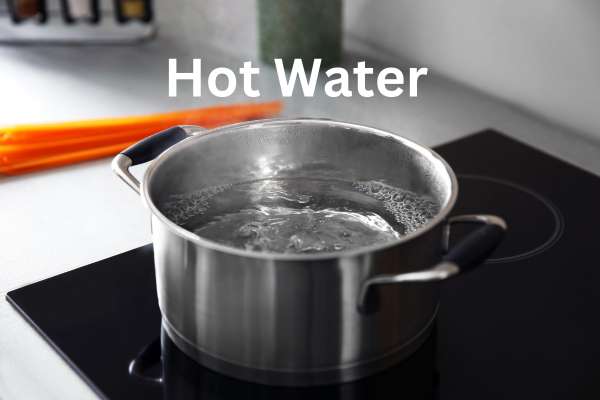
Hot water is an essential tool in every kitchen, And it plays a vital role in keeping your Calphalon cookware looking brand new. Calphalon is known for its high-quality and durable cookware that can last a lifetime. However, without proper cleaning, even the best cookware can lose its original shine over time. The good news is that cleaning your Calphalon cookware is easy with the right process, And hot water is part of it.
The first step to clean your Calphalon cookware using hot water is to rinse it with warm water immediately after use. This will help remove any food particles or debris from the surface of the pot or pan. After rinsing, fill the pot or pan with hot soapy water and let it soak for a few minutes. While soaking, You can take advantage of this time to do other tasks in your kitchen.
Process2: Baking Soda
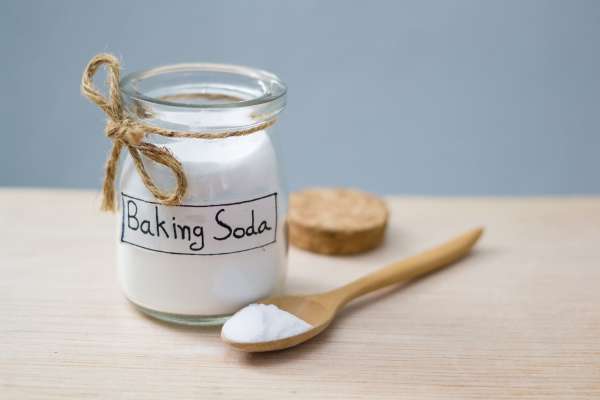
Baking soda is a versatile ingredient used in many household cleaning and cooking applications. When it comes to maintaining the quality of your Calphalon cookware, baking soda is your best friend. It’s an effective and cheap way to remove stubborn stains and unpleasant odors from your pots and pans without damaging them. Here are some simple steps to follow when using baking soda for cleaning Calphalon cookware.
However, Mix two tablespoons of baking soda with half a cup of water until it forms a thick paste. Then, apply the paste onto the surface of your cookware, focusing on areas with caked-on food or stains. Gently scrub the surface using a sponge or cloth until all residue has been removed. Rinse the cookware thoroughly with warm water and dry it with a clean towel.
Process3: White Vinegar

White vinegar is a versatile and affordable household essential that can be used for cleaning, cooking, And even as a beauty aid. When it comes to cleaning Calphalon cookware, White vinegar is the best choice due to its gentle yet effective cleansing properties. The clean process with white vinegar is also incredibly easy and requires only a few simple steps.
To clean your Calphalon cookware with white vinegar, start by filling the pot or pan with equal parts water and white vinegar. Bring the mixture to a boil on high heat before lowering the heat and allowing it to simmer for about fifteen minutes as well as. Once done, remove from heat and let the mixture cool before draining it out. Rinse thoroughly with warm water and dry with a soft cloth.
Process4: Salt And Lemon

This natural and effective cleaning process can remove even the toughest stains and buildup from your pots and pans.
To begin, sprinkle a generous amount of salt onto the affected area of your cookware. Cut a lemon in half and use one-half to scrub the salt into the surface. The combination of abrasive salt and acidic lemon juice works together to break down grease, grime, And other stubborn residues that can accumulate over time.
Once you’ve thoroughly scrubbed your Calphalon cookware with salt and lemon, rinse it under warm water to remove any remaining residue. Then dry it off with a soft towel or cloth before storing it away.
Process5: A Soft Sponge
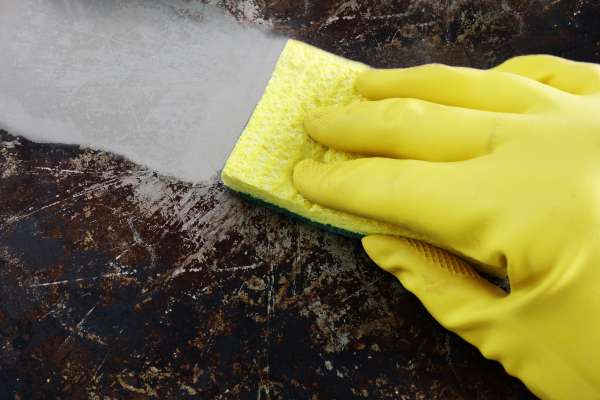
A soft sponge is one of the essential tools for keeping your cookware in excellent condition. But, did you know that not all sponges are created equal when it comes to cleaning these high-quality pots and pans? Choosing the right type of sponge can make a world of difference in how easily and effectively you can clean your cookware.
When it comes to cleaning Calphalon cookware, using a non-abrasive or soft sponge is key. The non-stick surface on most Calphalon pots and pans can scratch easily if cleaned with a harsh abrasive tool. Instead, opt for a soft sponge made specifically for non-stick surfaces, such as those made from microfiber or natural materials like cellulose. These gentle sponges will help remove any food residue or stains without damaging the surface of your pans.
Process6: Tartar
Tartar build-up is a common problem that can occur on your Calphalon cookware. If left untreated, This build-up can not only negatively affect the performance of your cookware but can also lead to health concerns. Luckily, with the right cleaning process, You can easily remove tartar from your cookware and keep it in top condition for years to come.
The best way to clean tartar from Calphalon cookware is by using a combination of baking soda and vinegar. Start by filling the affected pot or pan with hot water and add 1-2 cups of white vinegar (depending on the size of the pot/pan). Take this mixture to a boil for about 10 minutes before adding 2-3 tablespoons of baking soda. You will notice fizzing as soon as you add in baking soda.
Process7: A Soft-Bristle Dish Brush
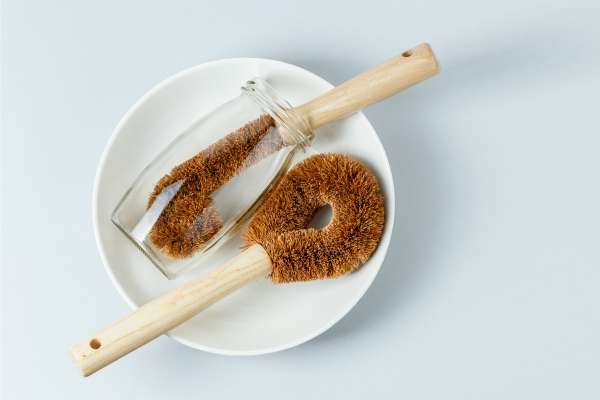
Using a soft-bristle dish brush is also an essential part of the best cleaning process for your Calphalon cookware. The gentleness of these brushes allows you to scrub away food residues and debris without damaging any non-stick coatings or other finishes on your pots and pans. Additionally, using a soft-bristle dish brush helps prevent bacteria growth by removing leftover food particles that can cause odors and contamination.
Process8: A Mild Liquid Dish Soap

Our mild liquid dish soap is formulated with ingredients that are tough on grease and grime but gentle on delicate surfaces like stainless steel and non-stick coatings. Unlike other harsh soaps that can strip away the protective coating of your cookware, our product helps protect and preserve it for years to come. It’s also easy to rinse off which means no residue or streaks will be left behind after washing.
Process9: Paper Towel
Paper towels are a staple in every household, And when paired with the right cleaning process, They can work wonders. For those who have invested in Calphalon cookware, It’s important to ensure that these high-quality pots and pans are kept clean and free of any residue or stains. The best way to achieve this is by using a tried-and-tested cleaning process that includes the use of paper towels.
The first step is to make sure that your Calphalon cookware has cooled down completely before attempting to clean it. Once it has cooled, rinse the pot or pan under hot water to remove any excess food particles. Next, take a paper towel and fold it into quarters for extra absorbency. Dampen the towel slightly with warm water and add a drop of dish soap onto its surface.
Best Cleaning Tips For Calphalon Cookware
Every Day Cleaning
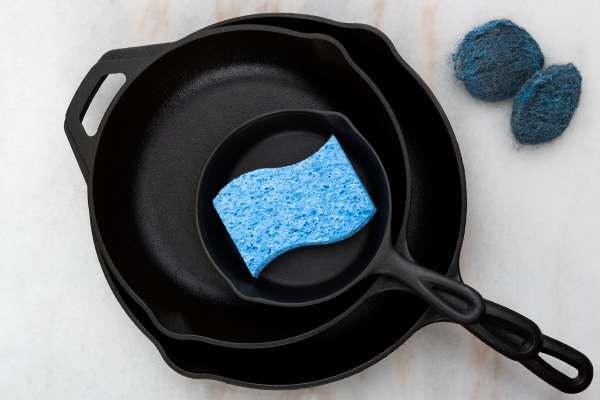
Regular cleaning helps to maintain the quality of your pots and pans, making them more durable and long-lasting. Here are some tips for everyday cleaning of your Calphalon cookware.
Firstly, always let your cookware cool down before washing it. This is because hot water can cause warping or discoloration of the metal surface. Once cooled, Use mild detergent and warm water to clean the pots and pans using a non-abrasive scrubber or sponge. Avoid steel wool or harsh detergents as they can damage the surface of the cookware.
Secondly, don’t forget to clean any residue from cooking oils or grease after each use as these can build up over time and affect the quality of your food.
Regular Cleaning For Hard Anodized Calphalon Pans
Hard anodized Calphalon pans are especially durable, but they still require regular cleaning to maintain their quality and extend their lifespan. We will share some valuable cleaning tips for Calphalon cookwares that will help you keep your hard anodized pans in top condition.
It’s important to clean your Calphalon pans after each use to prevent the buildup of food residue or stains. Use warm water and mild dish soap to wash the pan thoroughly. Avoid using abrasive sponges or harsh cleaners as they can damage the nonstick coating of the pan. Instead, Use a soft-bristled brush or sponge to gently scrub away any food particles.
Deep Cleaning For Burnt Calphalon Pans

First things first: never put your Calphalon pans in the dishwasher. While they may technically be dishwasher safe, The harsh detergents and high temperatures can damage the coating over time. Instead, aim to clean them by hand using warm water and dish soap. For tougher stains or burnt-on food, fill the pan with water and bring it to a boil on the stovetop before adding baking soda or vinegar to loosen things up.
Clean The Bottom Of Calphalon Pans
For cooking enthusiasts who love to use their Calphalon pans regularly, It’s essential to learn how to clean the bottom of these pans effectively. Cleaning the bottom of Calphalon pans is to remove any excess grease or food particles with a paper towel. Next, fill your sink or a large basin with hot water and add dish soap. Place your pan in the soapy water and let it soak for at least 30 minutes or longer if necessary. After soaking, Use a non-abrasive sponge or cloth to scrub away any remaining residue gently.
Cleaning Stubborn Stains And Mess
One of the most effective ways to clean stubborn stains on your cookware is by using baking soda. Baking soda is an excellent natural cleaner that helps remove tough stains without damaging the surface of your cookware. Simply mix baking soda with water to create a paste, Then apply it to the stained areas of your cookware using a soft sponge or cloth. Let it sit for about 10-15 minutes and then rinse it off with warm water.
What Can You Do With Old Calphalon Pans?
Old Calphalon pans can be reused in a variety of ways. First and foremost, They can be used as regular cooking pans. Calphalon is known for its durable construction and reliable performance, So your old pans should still work just fine. In this case, You can also use them to bake in the oven or on the stovetop.
In addition to cooking with them, You can also repurpose old Calphalon pans into other useful items around the house. For example, You could use a large pan as a planter for herbs or flowers, or use a smaller one as an organizer for small items like office supplies or jewelry. You could even hang several small pans from a wall to create an interesting wall art display.
Why Does My Calphalon Pan Have White Film?
Calphalon pans can develop a white film over time due to mineral deposits and other materials that have built up on the pan. This is especially true if you live in an area with hard water, As the minerals in hard water can leave behind residue on your cookware. To remove the white film, start by soaking the pan in hot water and a few drops of dish soap for about 15 minutes. After soaking, scrub the pan with a non-abrasive sponge or cloth and rinse it off with warm water. If this doesn’t work, You can try using baking soda or vinegar to help loosen any stubborn deposits. For tough spots, Use a damp cloth or steel wool to gently scrub away any remaining residue. Once all of the white films are gone, Be sure to dry the pan thoroughly before using it again.
What Are The Different Types Of Calphalon Cookwares?
This offers a variety of different types of cookware to suit any cooking needs.
The most popular type of cookware is the non-stick variety. This type of cookware has a special non-stick coating that prevents food from sticking to the pan and makes cleaning up easy. The non-stick coating also helps to evenly distribute heat, So your food cooks evenly without burning or sticking.
Calphalon also offers stainless steel cookware, Which is ideal for searing and browning foods. Stainless steel is durable and long-lasting, making it a great investment for your kitchen. It also heats quickly and evenly, So you can get perfect results every time.
Calphalon also offers ceramic cookware, Which is perfect for those who prefer to avoid non-stick coatings. Ceramic cookware is naturally non-stick and provides even heat distribution while cooking.
When Should You Throw Away Calphalon Pans?
There may come a time when you need to throw away your Calphalon pans. Generally speaking, You should throw away your Calphalon pans if they have become warped, cracked, or otherwise damaged beyond repair. Additionally, If the non-stick coating has worn off or begun to flake off in pieces, It’s time to replace the pan.
When it comes to caring for your Calphalon pans, It’s important to always use non-abrasive utensils and never place the pan in a dishwasher. If you take proper care of your Calphalon pans, They can last for many years and provide excellent performance in the kitchen. If you notice any signs of wear or damage, however, It’s best to replace them as soon as possible so that you can get the most out of them.
The Final Thoughts
Clean Calphalon cookware is relatively simple and straightforward. With a few simple steps and the right products, You can keep your cookware looking like new for years to come. Always check the manufacturer’s instructions before beginning any cleaning process. As this will help ensure that your cookware lasts as long as possible. Additionally, Be sure to use gentle household cleaners with soft cloths and sponges to avoid scratching or damaging the cookware.
